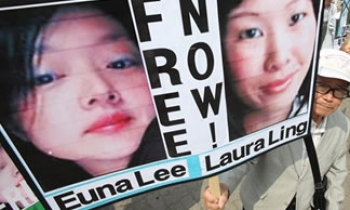Readers of some of the most prominent US newspapers will soon be greeted with an unusual sight over their morning coffee: advertisements on the front page and on the front of other sections.
In an industry where entrenched journalistic values and mounting commercial pressure have increasingly been on a collision course, the arrival of advertising on such hallowed editorial ground signals a significant new departure, and is already prompting a round of soul-searching in the higher reaches of American journalism.
"There's certainly no question that papers believe there is some sort of financial crisis and have used that to make these changes," says Leo Wolinsky, managing editor of the Los Angeles Times.
Journalists themselves should shoulder part of the blame, he adds. "The print world has been adept at singing the blues."
Last week, the Los Angeles Times and the Baltimore Sun both announced plans to put adverts on the front of various newspaper sections. That comes in the wake of the news that the Wall Street Journal will carry a single front-page advert after a redesign early next year. The New York Times is considering a similar step.
According to Bob Steele, an expert in ethics at the Poynter Institute, a non-profit institution set up to promote journalism education, the significance of this encroachment is more than just symbolic. Ceding space to advertising eats into the most prestigious news space and could add to a growing public suspicion that newspapers are too beholden to their advertisers.
While front-page advertising is familiar in newspapers with roots elsewhere in the world (including the Financial Times), it largely disappeared from US newspapers in the 1970s and 1980s. Coming after Watergate and the civil rights movement, "this was one of the finer periods in American journalism", and it enabled the nation's newsrooms to lay claim to their products' prime real estate, says Mr Steele.
The return now of front-page advertising is only part of a broader erosion of news departments that has seen both retrenchment of editorial staff and cuts in the space for editorial content.
Newspapers have also been coming down in size: both the Wall Street Journal and the New York Times will shrink their page size, though both say they will mitigate the loss of editorial space by adding pages and using the space available more effectively.
Gordon Crovitz, publisher of the Wall Street Journal, says that research among his newspaper's readers shows they prefer the new, smaller format. Also, the greater prominence of advertising in most other media – including the websites of newspapers themselves – has made readers more accustomed to commercial messages.
That message does not go down well with editorial departments. Newspaper website advertising only became so prominent in the first place because US newsrooms were slow to take an interest in the web and ceded that ground early on to the commercial departments, says Mr Wolinsky.
He and others point out that, despite the widespread perception of a financial crisis, profitability in the industry is close to its all-time high. Last year, overall operating profit margins climbed above 20 per cent, their best performance since the mid-1980s, says John Morton, an independent industry analyst.
Yet while profits remain solid, it has taken cost-cutting to achieve them, and the outlook for readership and advertising looks uncertain. The LA Times' circulation has fallen by 9 per cent in two years, to 870,000, while its revenue slipped by 1.5 per cent. In the six years since the paper was bought by Chicago's Tribune Co, its editorial staff has fallen by some 300, to 880.
Inroads like this have raised alarms in the newsrooms of papers that believe they still hold a unique place in fulfilling a public responsibility. "There is only a relative handful of papers that still have big ambitions for themselves," says Mr Wolinsky. Even these, it seems, will have to make more open concessions to commercial reality.









